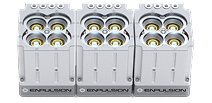FEEP Propulsion: Advancing Satellite Mobility and Space Innovation
How Electric Propulsion Is Powering the Next Frontier of Space Innovation
Once dismissed as science fiction and overshadowed for decades by more advanced chemical options, electric propulsion made a remarkable comeback in the early 2000s on high-profile scientific missions such as SMART-1 (2003) and DAWN (2007), validating its relevance for ambitious missions.
Since then, space technologies have evolved at a staggering pace, shifting from space missions dominated by large, government-led spacecraft to specialized missions powered by compact, agile satellites capable of sophisticated orbital maneuvers, scalable deployment, formation flying, and deorbiting. As the operational complexity of space missions grows, propulsion is a critical subsystem that remains at the forefront of new innovations.
Field-Emission Electric Propulsion (FEEP) is at the heart of this shift.
Satellite Autonomy
Historically, satellites and spacecraft had to wait for commands sent from a control center on Earth to act or react to a situation. That worked for decades, when there was far less traffic and debris in low Earth orbit. But that’s no longer the case. Now, spacecraft have to make decisions in real time to navigate hazards, refine orbits, and shift mission parameters without delay. And they have to do it quickly and accurately.
This level of autonomy requires an intelligent, responsive propulsion system to perform the maneuvers those conditions demand — and FEEP delivers.
The secret lies in the precision of the unit’s emitter tips. Each tip in a FEEP propulsion system can be shut down or enabled individually for fine power control. Instant throttle ability with micro- to millinewton thrust resolution offers the precision needed for orbital adjustments, sensor anomaly response, or other adjustments driven by onboard autonomy.
Formation Flying
Another complex technology feature mission planners look for is the reliable execution of formation flying. Multi-satellite systems acting as one cohesive architecture are opening doors to advanced capabilities like interferometry, stereoscopic imaging, and resilient communication networks.
Formation satellites are always fighting dynamic forces or orbital mechanics. Yet, it’s critical that they’re constantly in the right place, at the right time, in the right relation to their peers.
FEEP systems are some of the only propulsion technologies that can not only meet those demands but also excel at them. The same quick response that works so well for autonomy is at play here, as well as a dynamic 1,000 - 6,000 s Isp that enables micro-adjustments. This precision is so accurate that satellites can maintain formation at meter or even sub-meter scales.
Responsive Maneuvering
The rise of complex formations, diverse mission profiles, and a crowded orbital environment is reshaping how we think about spacecraft mobility. As design and fuel improvements allow spacecraft to stay in orbit longer, the need for in-orbit adjustments also increases.
All of these factors demand a fast response to stay out of the way, accomplish a task, or adjust a path.
Enpulsion’s FEEP systems are built for repeatable, safe maneuvering. With the unique advantage of high thrust-to-power efficiency in a small, passive design, their thrust range spans several magnitudes (from micro- to millinewtons) without the risk of mechanical delay. This advantage delivers incredible consistency under pressure, enabling rapid change in velocity without sacrificing precision.
Forging Ahead with FEEP
Technology has a way of starting off large, loud, slow, and clunky before refining down to compact, efficient machines. Just think about your first cell phone versus your current smartphone — the device that used to be used exclusively for phone calls now has an entire personal computer inside.
Enpulsion’s scalable, compact FEEP systems are built to do more than meet expectations — they’re built to make the extraordinary achievable. Explore our white papers to see how we’re solving real-world propulsion challenges today. And if your mission demands precision beyond the ordinary, our experts are ready to help you make it possible. Contact us today.
Get the latest information on Enpulsion innovation.
Subscribe to stay up to date on Enpulsion news, technology updates, and industry events.





